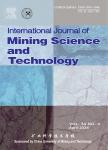Investigations into the identification and control of outburst risk in Australian underground coal mines
Investigations into the identification and control of outburst risk in Australian underground coal mines作者机构:PacificMGMBulli 2516Australia Department of CivilMining and Environmental EngineeringUniversity of WollongongWollongong 2500Australia
出 版 物:《International Journal of Mining Science and Technology》 (矿业科学技术学报(英文版))
年 卷 期:2017年第27卷第5期
页 面:749-753页
核心收录:
学科分类:0808[工学-电气工程] 0709[理学-地质学] 0819[工学-矿业工程] 081903[工学-安全技术及工程] 08[工学] 0807[工学-动力工程及工程热物理] 0708[理学-地球物理学] 0818[工学-地质资源与地质工程] 0815[工学-水利工程] 0813[工学-建筑学] 0814[工学-土木工程]
主 题:Outburst Desorption rate DRI Threshold limit
摘 要:Australian coal mines currently use gas content to assess outburst risk. The gas content threshold values for each mine are indirectly determined from measurement of gas volume liberated from 150 g coal samples during Q_3 residual gas content testing. It has been more than twenty years since this method, known as desorption rate index(DRI), was presented to the Australian coal industry, and in that time, there have been significant changes in mining conditions and the outburst threshold limits used at the benchmark Bulli seam mines. NSW Regulations list matters to be considered in developing control measures to manage the risk of gas outburst, and specifies that gas content, or DRI method, is used as the basis for determining outburst control zone. Whilst Queensland Regulations state that a coal or rock outburst is a high potential incident, there is no guidance provided to assist mine operators to define outburst prone conditions. A research project is planned at UOW to investigate the application of the DRI method and other potentially significant factors, such as gas pressure, coal toughness and permeability, which can be utilised by mine operators to assess outburst risk and determine appropriate outburst threshold limits and controls.



